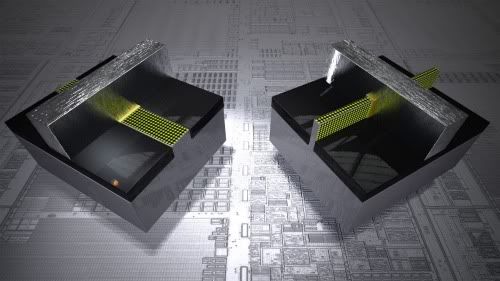
RACHEL COURTLAND
From what I remember of Honey, I Shrunk the Kids, getting zapped by Wayne Szalinskis shrink ray was not a cause for celebration. But Intel senior fellow Mark Bohr, who submits to a virtual miniaturization process that leaves him 100nm tall, seems positively gleeful in this new video from the company.
Bohr is celebrating Intels new, smaller, and, for the first time, three-dimensional transistor. Dubbed Tri-Gate, the device employs a much-anticipated design innovation multiple gates that wrap around a raised silicon channel.
The transistors will appear in Intel's new "Ivy Bridge" microprocessor, which will be made using a 22nm manufacturing process and begin shipping later this year. Intel's processor is the first make the jump from 32nm to 22nm, continuing the decades-long race to keep boosting the number of transistors that can be packed into the same amount of space.
The switch to 3D addresses some fundamental problems that have been plaguing transistors as their feature size has shrunk. Transistors have long been two-dimensional affairs, with a source and a drain separated by a channel along which electrons flow. The only components that sit above the plane are the gate, which turns on and off the flow of electrons, and a thin, insulating layer sandwiched between the gate and the channel.
But as engineers have made transistors smaller and smaller, the distance from the source to the drain has gotten so short that electrons can leak through the lower part of the channel, where the gate's influence is weakest, wasting power. To solve the leakage problem, transistor designers have been eyeing three-dimensional designs in which electrons have no place to go that isnt controlled by the gate.
Intels solution is a FinFET design that employs a ridge-like silicon channel that juts out of the silicon substrate. The transistors gate runs perpendicular to the channel and drapes over it, creating three gates around the channel.
Intel reports its new 3D, 22nm transistors are 37 percent faster at low voltage compared to Intel's current 32nm planar transistors, making them better for smartphones and other handheld devices. They draw less than half the power as the firms 32nm chips.
Despite that, the New York Times says, some think Intel is making a gamble, because alternative approaches may offer better gains on the power front:
There has been industry speculation that FinFET technology will give Intel a clear speed advantage, but possibly less control over power consumption than alternative approaches...The scope of Intels gamble is underscored by the fact that while the company dominates in the markets for data center computers, desktops and laptops, it has largely been locked out of the tablet and smartphone markets which are growing far more quickly than the traditional PC industry.
Intel made a tentative step into the low power market last month, with the introduction of its first processor for tablet computers.

